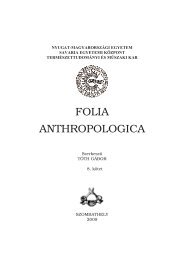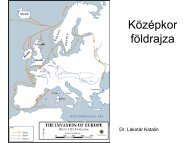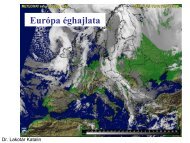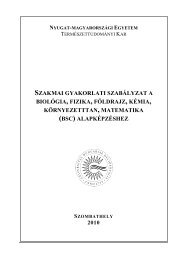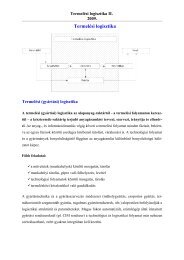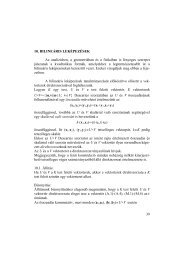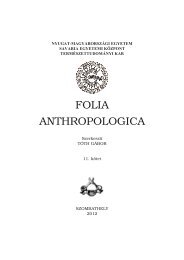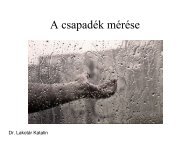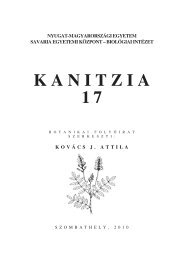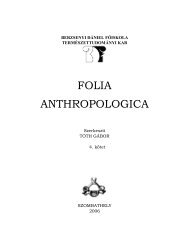Kanitzia 18. - NYME Természettudományi Kar - Nyugat ...
Kanitzia 18. - NYME Természettudományi Kar - Nyugat ...
Kanitzia 18. - NYME Természettudományi Kar - Nyugat ...
You also want an ePaper? Increase the reach of your titles
YUMPU automatically turns print PDFs into web optimized ePapers that Google loves.
K A N I T Z I A <strong>Kanitzia</strong> 18:13–28., Szombathely, 2011<br />
Journal of Botany<br />
A SZENTENDREI RÓZSA (ROSA SANCTI ANDREAE)<br />
NEVEZÉKTANI ÉS TAXONÓMIAI PROBLÉMÁI<br />
KERÉNYI-NAGY VIKTOR<br />
NymE, Erdőmérnöki <strong>Kar</strong>, Növénytani és Természetvédelmi Intézet<br />
Sopron, kenavil@gmail.com<br />
Abstract<br />
Kerényi-Nagy V. (2011): Nomenclatural and taxonomical problems related to the Rosa sancti andreae.<br />
<strong>Kanitzia</strong> 18: 13–28.<br />
Originally Linneaus gived a very short diagnosis for Rosa villosa (1753). This species growing in<br />
Europe and Asia Minor, it has many different type everywhere – so the taxonomists discribed many<br />
new (micro) species from this group, and the R. villosa become a species-agg. Degen (1924) described<br />
a new endemic species from this group, named Rosa sancti-andreae.<br />
In this article we present the nomenclatural and taxonomical problems related to the R. sancti andreae.<br />
It is necessary to be studied the all taxa from the R. villosa aggregata in Carpathian Basin. The Rosa<br />
sancti andreae may be associated with the following taxa: Rosa villosa L. (1753), R. pomifera HERR-<br />
MANN (1762), R. mollis SMITH (1813), R. ciliato-petala BESSER (1822), R. mollissima FRIES (1828), R.<br />
velebitica (BORBÁS ex H. BRAUN, 1892) DEGEN (1937), R. sancti-andreae DEGEN et TRAUTMANN (1924)<br />
and R. coziae NYÁRÁDY (1955). In the nomenclature-problem we must checking every taxa’s original<br />
diagnosys and holo- or lectotype. In our oppinon: the R. villosa agg. has 4 different species in the<br />
Carpathian Basin: R. velebitica (BORBÁS ex H. BRAUN) DEGEN, R. coziae NYÁRÁDY, R. villosa L. (subsp.<br />
villosa et subsp. mollis (SMITH) CRÉPIN) and R. ciliato-petala BESSER. We consider that R. sancti andreae<br />
Degen et Trautman is a synonimous taxon with the R. ciliato-petala Besser. We made an areamap (Fig.<br />
6.) of these taxa with the literature and herbaria (BP, GAH, SAV, SLO, ZA) datas. We presented the<br />
lectotype of R. ciliato-petala BESS. (Fig. 7, 8) and, we designeted the lectotype of Rosa sancti-andreae<br />
DEG. et TRAUTM. (Fig. 9, 10; № 703224 in BP) and Rosa pomifera HERRM. var. baldensis EVERS (№<br />
174219 in BP). It was elaborated an identification-key of these taxa for the easy determination.<br />
Key words: Rosa sancti-andreae, R. ciliato-petala, R. coziae, R. velebitica, Rosa villosa.<br />
Bevezetés<br />
A szentendrei rózsa leírása óta (DEGEN 1924) foglalkoztatja az európai botanikus<br />
társadalmat. Az öreg kontinens olyan kiemelkedő botanikusai nyilatkoztak eme rózsa<br />
ügyében, mint az osztrák Fridrich EHRENDORFER (1973), a magyar SOÓ Rezső (1970, 1980),<br />
a cseh Ivan KLÁŠTERSKÝ (1969), a magyar FACSAR Géza (1993), és a lengyel Ryszard POPEK<br />
(1996). Jelen cikkben a taxon nevezéktani-taxonómiai problémáit szeretném tisztázni az<br />
őshonosság-kultúrreliktumság megfejtése nélkül.<br />
Anyag és módszer<br />
A probléma tisztázásához a taxonok eredeti diagnózisait vetettem össze, s amenynyiben<br />
módomban állt, a típuspéldányokat is. Az idézett diagnózisoknál megtartottam a<br />
helyesírást és a szöveg szedésének stílusát is. A szemléltető jellegű térképeken az élőhelyek<br />
13




